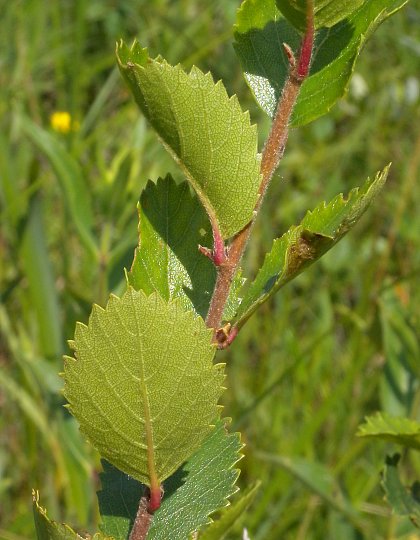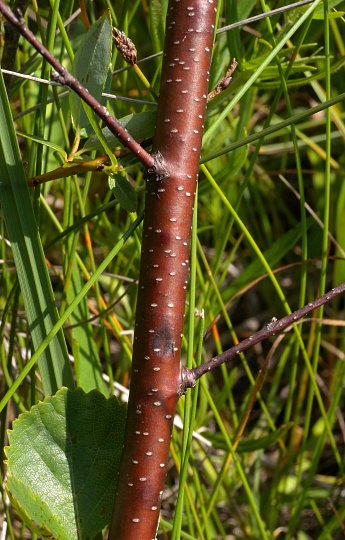Description:
This is a low shrub up to 6' high (rarely higher) that is irregularly
branched. The bark of the trunk or lower branches is gray and slightly
rough-textured; it doesn't peel away in strips. The bark of twigs and
upper branches is reddish brown and smooth with scattered white
lenticels; sometimes it becomes covered with a glaucous gray sheen.
Young shoots are light green to light brown and they usually have
non-glandular hairs; there are less common varieties of this shrub that
have glabrous or glandular-hairy shoots. Alternate deciduous leaves
occur along the shoots and twigs. The leaves are up to 1¾" long and 1½"
across (rarely larger); they are obovate, oval, or nearly orbicular in
shape, while their margins are coarsely dentate. The leaf tips are
rounded or obtusely angled, while the leaf bases are rounded to broadly
wedge-shaped. The upper leaf surface is medium green (or reddish green
while young), either shiny or
dull, and hairless, while the lower leaf surface is pale green to
whitish green (or reddish green while young), and either hairless or
variably hairy. In one variety of
this shrub, the lower leaf surface is glandular-pitted. The short
petioles are up to ¼" long, light green to red, and either glabrous or
hairy. Bog Birch is monoecious, producing male catkins and female
catkins on the same shrub. The male catkins develop during the autumn
at the tips of last year's twigs and overwinter.

During the blooming period, they become ¾–1¼" long, brownish yellow, cylindrical in shape, and spreading or pendent. Behind each scale of a male catkin, there are several stamens from a cluster of 3 male flowers. The female catkins develop during the spring from the floral buds of young twigs; they are ½–¾" long, green, short-cylindrical in shape, and erect. Behind each scale of a female catkin, there is a cluster of 3 female flowers; each female flower consists of a naked ovary with a divided style. The blooming period occurs from mid- to late-spring, lasting 1-2 weeks. The flowers are cross-pollinated by the wind. Afterwards, the male catkins wither away, while the female catkins persist, becoming slightly more elongated, and turning brown at maturity. The woody scales of mature female catkins are 3-lobed; the 2 lateral lobes develop at right-angles from the central lobe, and they are shorter than it. The nutlet bodies are broadly ellipsoid and compressed in shape; the 2 lateral wings of the nutlets are slightly more narrow than the nutlet bodies. The root system is shallow and woody, sometimes forming clonal offsets from underground runners. Sometimes this shrub also reproduces by layering, when lower branches become lodged in the soil and develop rootlets.

Cultivation: This shrub prefers full or partial sun, wet to moist conditions (although not standing water), and either peaty soil or calcareous sand. It is very winter-hardy.
Range & Habitat: The native Bog Birch occurs in NE Illinois, where it is uncommon (see Distribution Map). Illinois lies along the southern-range limit of this species. It tends to be more common in boreal areas further to the north. Habitats include forested larch bogs, shrubby margins of open bogs, calcareous fens, and margins of calcareous sand flats (pannes) along Lake Michigan. In Illinois, this shrub is found in high quality natural areas. Unfortunately, an introduced shrub, Frangula alnus (Glossy Buckthorn), has invaded some of the habitats where Bog Birch occurs, and this introduced shrub is threatening to displace it.

Faunal Associations: Several insect species have been observed to feed on Bog Birch (Betula pumila) in its various habitats. These species include the Witch Hazel Spiny Gall Aphid (Hamamelistes spinosus) and other aphids (Calaphis manitobensis, Cedoaphis incognita, Cepegillettea betulaefoliae), plant bugs (Psallus parshleyi, Noctuocoris incognita), Gladiator Meadow Katydid (Orchelimum gladiator), Fork-tailed Bush Katydid (Scudderia furcata), and larvae of a buck moth (Hemileuca sp.); see Hottes & Frison (1931), Blackman & Eastop (2013), Discover Life (www.discoverlife.org), Knight (1941), Gangwere (1961), and Kruse (1998) for more information. Many other insect species are known to feed on birches (Betula spp.), including the larvae of wood-boring beetles, weevils, leaf beetles, larvae of bark beetles, seed bugs, armored scales, larvae of sawflies, and larvae of many moths. Among vertebrate animals, White-tailed Deer are known to browse on the twigs and foliage of Bog Birch in Canada, decreasing its size (Pellerin et al., 2006). In addition, the Greater Prairie Chicken used Bog Birch as winter browse in Wisconsin, feeding on its buds and catkins (Hamerstrom et al., 1941). The buds and nutlets of birches are a source of food for such songbirds as chickadees, finches, and juncos.

Photographic Location: Edge of a moist sand flat along Lake Michigan at the Illinois Beach State Park in NE Illinois. The photographed shrub is the typical variety of Bog Birch, Betula pumila pumila.
Comments: This is the only birch in Illinois that is a shrub. Other shrubby birches (Betula spp.) exist in North America, but they occur in boreal and arctic areas further to the north. Several varieties of Bog Birch (Betula pumila) have been described; three of them occur in Illinois. The typical variety, Betula pumila pumila, is the most common variety within the state. Its shoots and young twigs are covered with non-glandular hairs. Another variety, Betula pumila glandulifera, is very similar, except its shoots and young twigs are covered with glandular hairs, and its leaf undersides are glandular-pitted. The third variety, Betula pumila glabra, has shoots and young twigs that are hairless and its leaves are always hairless. The leaves of the other varieties can be either hairless or variably hairy on their leaf undersides.

During the blooming period, they become ¾–1¼" long, brownish yellow, cylindrical in shape, and spreading or pendent. Behind each scale of a male catkin, there are several stamens from a cluster of 3 male flowers. The female catkins develop during the spring from the floral buds of young twigs; they are ½–¾" long, green, short-cylindrical in shape, and erect. Behind each scale of a female catkin, there is a cluster of 3 female flowers; each female flower consists of a naked ovary with a divided style. The blooming period occurs from mid- to late-spring, lasting 1-2 weeks. The flowers are cross-pollinated by the wind. Afterwards, the male catkins wither away, while the female catkins persist, becoming slightly more elongated, and turning brown at maturity. The woody scales of mature female catkins are 3-lobed; the 2 lateral lobes develop at right-angles from the central lobe, and they are shorter than it. The nutlet bodies are broadly ellipsoid and compressed in shape; the 2 lateral wings of the nutlets are slightly more narrow than the nutlet bodies. The root system is shallow and woody, sometimes forming clonal offsets from underground runners. Sometimes this shrub also reproduces by layering, when lower branches become lodged in the soil and develop rootlets.

Cultivation: This shrub prefers full or partial sun, wet to moist conditions (although not standing water), and either peaty soil or calcareous sand. It is very winter-hardy.
Range & Habitat: The native Bog Birch occurs in NE Illinois, where it is uncommon (see Distribution Map). Illinois lies along the southern-range limit of this species. It tends to be more common in boreal areas further to the north. Habitats include forested larch bogs, shrubby margins of open bogs, calcareous fens, and margins of calcareous sand flats (pannes) along Lake Michigan. In Illinois, this shrub is found in high quality natural areas. Unfortunately, an introduced shrub, Frangula alnus (Glossy Buckthorn), has invaded some of the habitats where Bog Birch occurs, and this introduced shrub is threatening to displace it.

Faunal Associations: Several insect species have been observed to feed on Bog Birch (Betula pumila) in its various habitats. These species include the Witch Hazel Spiny Gall Aphid (Hamamelistes spinosus) and other aphids (Calaphis manitobensis, Cedoaphis incognita, Cepegillettea betulaefoliae), plant bugs (Psallus parshleyi, Noctuocoris incognita), Gladiator Meadow Katydid (Orchelimum gladiator), Fork-tailed Bush Katydid (Scudderia furcata), and larvae of a buck moth (Hemileuca sp.); see Hottes & Frison (1931), Blackman & Eastop (2013), Discover Life (www.discoverlife.org), Knight (1941), Gangwere (1961), and Kruse (1998) for more information. Many other insect species are known to feed on birches (Betula spp.), including the larvae of wood-boring beetles, weevils, leaf beetles, larvae of bark beetles, seed bugs, armored scales, larvae of sawflies, and larvae of many moths. Among vertebrate animals, White-tailed Deer are known to browse on the twigs and foliage of Bog Birch in Canada, decreasing its size (Pellerin et al., 2006). In addition, the Greater Prairie Chicken used Bog Birch as winter browse in Wisconsin, feeding on its buds and catkins (Hamerstrom et al., 1941). The buds and nutlets of birches are a source of food for such songbirds as chickadees, finches, and juncos.

Photographic Location: Edge of a moist sand flat along Lake Michigan at the Illinois Beach State Park in NE Illinois. The photographed shrub is the typical variety of Bog Birch, Betula pumila pumila.
Comments: This is the only birch in Illinois that is a shrub. Other shrubby birches (Betula spp.) exist in North America, but they occur in boreal and arctic areas further to the north. Several varieties of Bog Birch (Betula pumila) have been described; three of them occur in Illinois. The typical variety, Betula pumila pumila, is the most common variety within the state. Its shoots and young twigs are covered with non-glandular hairs. Another variety, Betula pumila glandulifera, is very similar, except its shoots and young twigs are covered with glandular hairs, and its leaf undersides are glandular-pitted. The third variety, Betula pumila glabra, has shoots and young twigs that are hairless and its leaves are always hairless. The leaves of the other varieties can be either hairless or variably hairy on their leaf undersides.